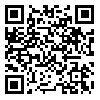Volume 77, Issue 5 (August 2019)
Tehran Univ Med J 2019, 77(5): 308-313 |
Back to browse issues page
Download citation:
BibTeX | RIS | EndNote | Medlars | ProCite | Reference Manager | RefWorks
Send citation to:



BibTeX | RIS | EndNote | Medlars | ProCite | Reference Manager | RefWorks
Send citation to:
Anoushiravani A A, Moini A, Hajihossein R, Alimoradian A, Didehdar M. Investigation of pulmonary fungal infections in immunocompromised patients. Tehran Univ Med J 2019; 77 (5) :308-313
URL: http://tumj.tums.ac.ir/article-1-9874-en.html
URL: http://tumj.tums.ac.ir/article-1-9874-en.html
Ali Arash Anoushiravani1 
 , Abdollatif Moini2
, Abdollatif Moini2 
 , Reza Hajihossein3
, Reza Hajihossein3 
 , Abbas Alimoradian4
, Abbas Alimoradian4 
 , Mojtaba Didehdar *
, Mojtaba Didehdar * 
 5
5

 , Abdollatif Moini2
, Abdollatif Moini2 
 , Reza Hajihossein3
, Reza Hajihossein3 
 , Abbas Alimoradian4
, Abbas Alimoradian4 
 , Mojtaba Didehdar *
, Mojtaba Didehdar * 
 5
5
1- Department of Internal Medicine, School of Medicine, Arak University of Medical Sciences, Arak, Iran. Department of Internal Medicine, School of Medicine, Iran University of Medical Sciences, Tehran, Iran.
2- Department of Internal Medicine, School of Medicine, Arak University of Medical Sciences, Arak, Iran.
3- Department of Medical Parasitology and Mycology, School of Medicine, Arak University of Medical Sciences, Arak, Iran.
4- Department of Pharmacology, School of Medicine, Arak University of Medical Sciences, Arak, Iran.
5- Department of Medical Parasitology and Mycology, School of Medicine, Arak University of Medical Sciences, Arak, Iran. ,didehdar_m@arakmu.ac.ir
2- Department of Internal Medicine, School of Medicine, Arak University of Medical Sciences, Arak, Iran.
3- Department of Medical Parasitology and Mycology, School of Medicine, Arak University of Medical Sciences, Arak, Iran.
4- Department of Pharmacology, School of Medicine, Arak University of Medical Sciences, Arak, Iran.
5- Department of Medical Parasitology and Mycology, School of Medicine, Arak University of Medical Sciences, Arak, Iran. ,
Abstract: (8564 Views)
Background: With increasing immunocompromised patients, fungal infections especially lung infection, have also increased. In this study, fungal contamination of the respiratory system in immunocompromised patients was evaluated.
Methods: This descriptive cross-sectional study was conducted in immunocompromised patients suspicious of pulmonary infections referring to specialized lung clinic of Amir-Al-Momenin University Hospital in Arak City, Iran, from April 2017 to June 2018. Of these 64 patients, including 35 women and 29 men, were selected. After recording the demographic information, a bronchoalveolar lavage (BAL) sample was prepared by the physician from these patients and was immediately sent to the medical mycology laboratory, school of medicine. Bronchoalveolar lavage specimens were investigated by Grocott-Gomori's methenamine silver (GMS) staining and culture method. Data were analyzed by SPSS software, version 16 (IBM SPSS, Armonk, NY, USA).
Results: Of 64 patients, 9 (14%) were infected with pulmonary fungal infections. Among the patients infected with fungal infection, 9 (100%) were positive in the culture examine and 8 (72%) by GMS staining. Among infected people, 7 (77.8%) were female and 2 (22.2%) were male. The most common isolated fungi were Candida albicans, Aspergillus fumigatus and Mucor species (2 cases). The highest infection was seen in the age group of less than 60 (33.3%). 66.7% of infections were among the unemployed persons and 33.3% of other cases of infection were seen in people with free jobs, workers and employees. The most important factors in the development of pulmonary fungal infections in the patients were: 5 cases of malignancy (33.3%), corticosteroid use in 2 cases (33.3%), tuberculosis in 1 case (22.2%) and diabetes mellitus in 1 case (11.2%). There was no significant relationship between fungal contamination with sex, age, occupation, marriage and type of disease.
Conclusion: The results of this study showed that immunocompromised patients are prone to fungal infections, especially Candidiasis and Aspergillosis. Therefore, the use of control methods to reduce the probability of such patients to fungal infections should be considered.
Methods: This descriptive cross-sectional study was conducted in immunocompromised patients suspicious of pulmonary infections referring to specialized lung clinic of Amir-Al-Momenin University Hospital in Arak City, Iran, from April 2017 to June 2018. Of these 64 patients, including 35 women and 29 men, were selected. After recording the demographic information, a bronchoalveolar lavage (BAL) sample was prepared by the physician from these patients and was immediately sent to the medical mycology laboratory, school of medicine. Bronchoalveolar lavage specimens were investigated by Grocott-Gomori's methenamine silver (GMS) staining and culture method. Data were analyzed by SPSS software, version 16 (IBM SPSS, Armonk, NY, USA).
Results: Of 64 patients, 9 (14%) were infected with pulmonary fungal infections. Among the patients infected with fungal infection, 9 (100%) were positive in the culture examine and 8 (72%) by GMS staining. Among infected people, 7 (77.8%) were female and 2 (22.2%) were male. The most common isolated fungi were Candida albicans, Aspergillus fumigatus and Mucor species (2 cases). The highest infection was seen in the age group of less than 60 (33.3%). 66.7% of infections were among the unemployed persons and 33.3% of other cases of infection were seen in people with free jobs, workers and employees. The most important factors in the development of pulmonary fungal infections in the patients were: 5 cases of malignancy (33.3%), corticosteroid use in 2 cases (33.3%), tuberculosis in 1 case (22.2%) and diabetes mellitus in 1 case (11.2%). There was no significant relationship between fungal contamination with sex, age, occupation, marriage and type of disease.
Conclusion: The results of this study showed that immunocompromised patients are prone to fungal infections, especially Candidiasis and Aspergillosis. Therefore, the use of control methods to reduce the probability of such patients to fungal infections should be considered.
Type of Study: Original Article |
Send email to the article author
| Rights and permissions | |
 |
This work is licensed under a Creative Commons Attribution-NonCommercial 4.0 International License. |



